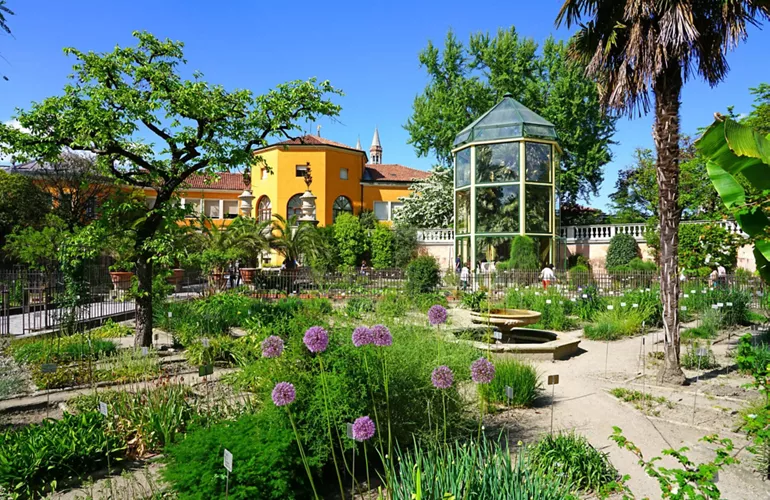This content was automatically translated. View the original text.

Overview
Over 6000 specimens in the Botanical Garden of Padua
It is the oldest university garden in the world and it is situated in the city of Padua. Established in 1545 for the cultivation of medicinal plants, this natural and architectural wonder, a UNESCO World Heritage Site since 1997, preserves almost seven thousand plant species, expressly divided by category to allow them to be observed and studied. This is a unique variety of specimens, rich in history.
The origins and structure of the Garden
Originally created for the cultivation of so-called simple plants, i.e. medicines coming directly from nature, the Botanical Garden of Padua was inaugurated in 1545, in a Renaissance cultural panorama that is clearly reflected in the architecture: indeed, the ideals of order, balance and geometry dominate in the ancient garden.
The trapezoidal shape of the available land, previously owned by the nearby monastery of St Justina, conditioned the layout of the Garden, which was designed according to a circular structure in which a square is inscribed, subdivided, in turn, by two perpendicular avenues into four regular, smaller squares. The four “quarters” are adorned with flowerbeds, which, in true keeping with the scientific fervour of the time, form elegant geometric designs that all differ from each other. A few years after the foundation, in order to prevent the constant nightly theft of the precious medicinal plants, (yes, you read that right!) a circular enclosure wall was built.
Subsequent modifications have not drastically altered the original design. The four monumental entrance portals and the fountains in the centre of each quarter date back to the 18th century, while the three cubic, spherical and cylindrical sundials and the “botanical theatre”, the hemicycle hall with a capacity of one hundred students, still used today for lectures and meetings, belong to the 19th century.
The Biodiversity Garden and educational workshops
The Biodiversity Garden was recently added to the original structure, with its display of around 1,300 species, grouped in homogeneous environments in terms of humidity and temperature. Educational workshops for schools and groups of students and adults are also held here. There are more than ten thematic routes with guided tours or in digital mode, accompanied by a remotely connected member of staff. The science box, containing all the necessary material, is sent to the class. Each workshop lasts between 60 and 90 minutes.
Padua, but World Heritage
The closely-knit network of international relations and the profound impact it exerts on the research environment has resulted in the Botanical Garden of Padua becoming a cultural asset in its own right on the UNESCO World Heritage List.
Indeed, it is a great contribution to the field of botanical sciences and an outstanding example of an ancient cultural tradition. “A cradle of science, scientific exchange and understanding of the relationship between nature and culture”, it has contributed to the advancement of numerous modern scientific disciplines, from botany to medicine, chemistry to ecology and pharmacy.
Discovering historic trees, from the virtual to the real
Do you now feel the urge to visit the Garden? If you come as a family, please note that there is an ad hoc entrance ticket. In any case, you can also visit the site digitally, from your living room, thanks to the image gallery of the virtual tour, but of course the live experience will be quite unforgettable. In both cases, exploring allows you to observe how the Garden changes over the course of the seasons.
Goethe's Palm and insect-eating plants
Two unmissable things. The section dedicated to historical trees includes a St. Peter's palm dating back to 1585, the oldest in the Garden of Padua. It is also known as Goethe's Palm, because it is said to have inspired the German writer, who visited Padua in the autumn of 1786, to develop his theory on the metamorphosis of plants.
And then there are the collections of medicinal and insectivorous plants. Incidentally, the use of insecticides is absolutely forbidden in the Botanical Garden of Padua: the control of insects and mites that harm plants is achieved by means of organic and integrated pest control strategies.